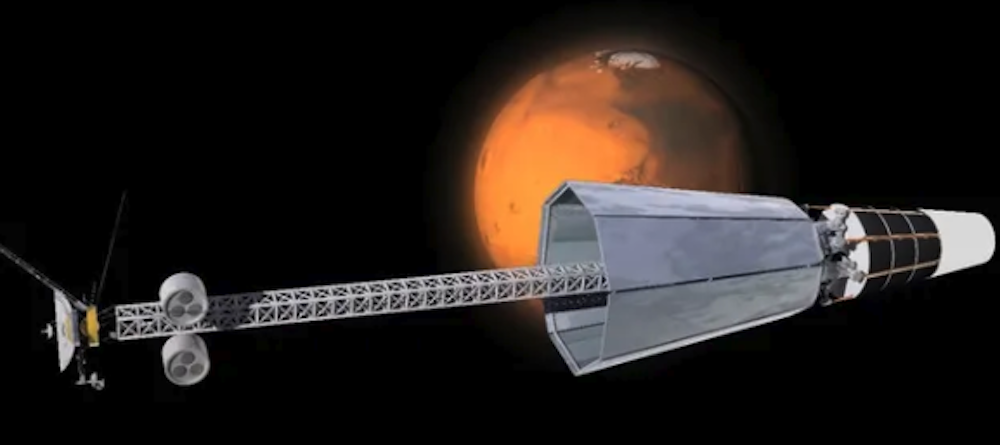stories on Nostr: Unlocking the Potential of Nuclear Spacecraft ( #12b2797b , v0.01) ...
Unlocking the Potential of Nuclear Spacecraft ( #12b2797b , v0.01)

Lockheed Martin has secured $33.7 million in funding from the Air Force Research Laboratory for the JETSON High Power program. This program aims to advance high-power nuclear electric propulsion and power technologies. Lockheed Martin will collaborate with BWX Technologies Inc. and Space Nuclear Power Corp. for the development, which will take place in Colorado, New Mexico, and Virginia. The JETSON program is a step towards using nuclear electric propulsion for human transportation to the moon, Mars, and beyond. The technology utilizes a fission reactor that transfers heat to Stirling engines, generating between six and 20 kilowatt-electric. Lockheed Martin states that this technology could provide higher electrical output than solar-powered spacecraft. The reactor remains inactive during launch and only starts the fission process when the spacecraft reaches a non-decaying orbit far from Earth.
In addition, the US Space Force has awarded contracts worth over $5.6 billion to SpaceX and United Launch Alliance (ULA) for 48 rocket launches as part of the National Security Space Launch (NSSL) Phase 2 contract awards. The Phase 2 orders have significantly increased, with the number of launches going from three in the first year to 21 in the fifth year. The Phase 3 bidding process is currently underway, with expectations of 17 missions ordered in the first year, 14 missions in the second year, and 16 missions in the third year. This block buy approach aims to reduce launch costs by allowing companies to prepare their supply chain for a longer timeframe. SpaceX is projected to generate more revenue from its Starlink business than its launch business next year. Other companies in the space industry, such as ViaSat and Hughes, have faced challenges including write-downs and subscriber losses, while companies like Iridium and Rocket Lab have reported positive financial results. Voyager and Airbus have also signed an agreement with the European Space Agency to explore opportunities for sustained access to space through the Starlab space station.
Sources:
- [Lockheed Martin Lands Funding for Nuclear Spacecraft](https://www.thomasnet.com/insights/lockheed-martin-lands-funding-for-nuclear-spacecraft/) (Thomasnet)
- [US Space Force Awards $5.6 Billion in Contracts to SpaceX and ULA](https://www.space.com/us-space-force-awards-spacex-ula-contracts) (Space.com)
#LockheedMartin #nuclearspacecraft #JETSONHighPowerprogram #nuclearelectricpropulsion #fissionreactor #Stirlingengines #spaceexploration #USSpaceForce #SpaceX #UnitedLaunchAlliance #NationalSecuritySpaceLaunch #rocketlaunches #Starlink #ViaSat #Hughes #Iridium #RocketLab #Voyager #Airbus #EuropeanSpaceAgency #Starlab
References:
- : https://www.thomasnet.com/insights/lockheed-martin-lands-funding-for-nuclear-spacecraft/

Lockheed Martin has secured $33.7 million in funding from the Air Force Research Laboratory for the JETSON High Power program. This program aims to advance high-power nuclear electric propulsion and power technologies. Lockheed Martin will collaborate with BWX Technologies Inc. and Space Nuclear Power Corp. for the development, which will take place in Colorado, New Mexico, and Virginia. The JETSON program is a step towards using nuclear electric propulsion for human transportation to the moon, Mars, and beyond. The technology utilizes a fission reactor that transfers heat to Stirling engines, generating between six and 20 kilowatt-electric. Lockheed Martin states that this technology could provide higher electrical output than solar-powered spacecraft. The reactor remains inactive during launch and only starts the fission process when the spacecraft reaches a non-decaying orbit far from Earth.
In addition, the US Space Force has awarded contracts worth over $5.6 billion to SpaceX and United Launch Alliance (ULA) for 48 rocket launches as part of the National Security Space Launch (NSSL) Phase 2 contract awards. The Phase 2 orders have significantly increased, with the number of launches going from three in the first year to 21 in the fifth year. The Phase 3 bidding process is currently underway, with expectations of 17 missions ordered in the first year, 14 missions in the second year, and 16 missions in the third year. This block buy approach aims to reduce launch costs by allowing companies to prepare their supply chain for a longer timeframe. SpaceX is projected to generate more revenue from its Starlink business than its launch business next year. Other companies in the space industry, such as ViaSat and Hughes, have faced challenges including write-downs and subscriber losses, while companies like Iridium and Rocket Lab have reported positive financial results. Voyager and Airbus have also signed an agreement with the European Space Agency to explore opportunities for sustained access to space through the Starlab space station.
Sources:
- [Lockheed Martin Lands Funding for Nuclear Spacecraft](https://www.thomasnet.com/insights/lockheed-martin-lands-funding-for-nuclear-spacecraft/) (Thomasnet)
- [US Space Force Awards $5.6 Billion in Contracts to SpaceX and ULA](https://www.space.com/us-space-force-awards-spacex-ula-contracts) (Space.com)
#LockheedMartin #nuclearspacecraft #JETSONHighPowerprogram #nuclearelectricpropulsion #fissionreactor #Stirlingengines #spaceexploration #USSpaceForce #SpaceX #UnitedLaunchAlliance #NationalSecuritySpaceLaunch #rocketlaunches #Starlink #ViaSat #Hughes #Iridium #RocketLab #Voyager #Airbus #EuropeanSpaceAgency #Starlab
References:
- : https://www.thomasnet.com/insights/lockheed-martin-lands-funding-for-nuclear-spacecraft/
